CITYVIEW’s Ultimate Taco Challenge
8/3/2022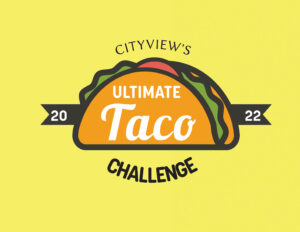 After Morgan Spurlock began his decent to infamy by making a documentary movie about eating an all-McDonald’s diet, a survey asked Americans what they would choose to eat if they could only eat one kind of food. Hamburgers were the first choice but, more surprisingly, tacos finished second.
After Morgan Spurlock began his decent to infamy by making a documentary movie about eating an all-McDonald’s diet, a survey asked Americans what they would choose to eat if they could only eat one kind of food. Hamburgers were the first choice but, more surprisingly, tacos finished second.
What is not to like about tacos? They are a complete meal in a tortilla. They can include salad, protein, fruit, dairy, eggs and spices. They are made with corn flour, wheat flour and even cactus flour. They can be warmed on a comal or deep fried. They can be served with tomato-based salsa, tomatillo salsa or “Christmas style” (red and green), which is particularly popular in New Mexico.
They can be found in fine dining restaurants, food trucks, taquerias, convenience stores, gas stations and street carts. They are popular for breakfast, lunch, dinner and dessert. They might be Mexico’s top cultural contribution to North America. In central Iowa, one can order them with cheese and lettuce, or with cilantro, chopped onions, pico de gallo, guacamole, sour cream and radishes. At Pueblo Viejo, you can get them with mariachi. At Fuzzy’s Taco Shop, they are served with sexual innuendo. At Abelardo’s, you can add pickled carrots and jalapenos. At most sit-down cafés, you order them with alcoholic beverages. Rita’s Cantina serves them with margarita flights. El Patio serves a blue corn tortilla option. At El Rey Market, Restaurant and Guns in Perry, you can order them with alcohol and firearms.
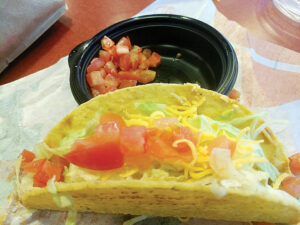
Taco Bell popularized the U-shaped tortilla and the word “taco” in the U.S.
They go by many names. Burritos are supersized tacos, in wheat tortillas. If you roll tacos into small tortillas and fry them, they are taquitos. If you roll them into larger tortillas, smother them in salsa and bake them, they become enchiladas. If you stuff and deep fry them, they are gorditas, sopes or huaraches. Cut them up for breakfast, and they are chilaquiles. If you stuff raw masa, wrap it and steam it, you have tamales. If you fry your tortilla and cover it in powdered sugar, you have churros. Cover it with ice cream or ice cream and honey, and it’s an ice cream taco. (Rita’s Cantina has both.)
It is this versatility which makes the idea of eating nothing but tacos appealing.
What does taco mean?
Tacos are an ancient food, but “taco” is a rather modern word. Most taco historians — yes, that is a thing — believe the word derived from a “plug” of gunpowder wrapped in paper to be pushed into holes in the great 18th-century silver mines that made Guanajuato, Queretaro and San Luis Potosi some of the wealthiest cities on Earth. So, taco translates most often as “plug,” but a taco packs the bang of an explosion. After that, tacos were known as “tacos de mineros,” or miners’ tacos. Ever since, they have been considered a working-class food.
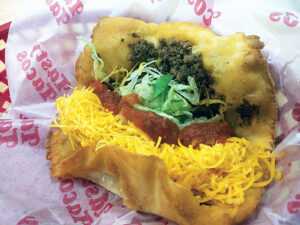
Des Moines’ original iconic taco, from Tasty Tacos.
By whatever name, tacos have been around since the middle of the first century B.C. Evidence of tortilla making in Oaxaca suggests that the first tacos might well have been made with fish or organ meat. The Valley of Oaxaca was also where Spaniards, led by Hernan Cortes and Pedro de Alvarado, discovered tomatoes, tomatillos, avocados and myriad chilies. Would tacos exist without Oaxacan contributions? Not as we know and love them.
Most contemporary definitions of the taco simply consider it a combination of foods eaten in a tortilla. After the Spanish colonists brought wheat to Mexico, particularly the northern province of Sonora, wheat tortillas have been as acceptable as corn tortillas. The Spanish also introduced cattle to Sonora in droves. Sonora is both the breadbasket and the beef capital of Mexico. When the first Mexican immigrants to Des Moines arrived in the early 20th century, many came from Sonora, and the first tacos here featured beef and often flour tortillas.
Coming to America
The taco was first introduced to the United States in 1905. Mexican migrants were coming to work on railroads and other jobs and started to bring their delicious foods with them. Tacos were essentially a street food at that time since they were cheap. Mexican food carts in San Antonio and Los Angeles were run by women called “chili queens,” and they became bona fide tourist attractions in San Antonio. They sold corn tortilla tacos and tamales. And, as became well known last month, they sold breakfast tacos. The tacos were described as the spiciest of foods by Will Rogers and others.
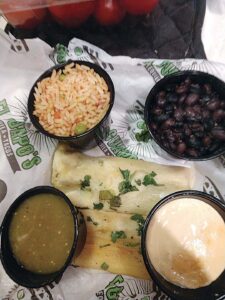
El Guapo makes all their tortillas from scratch.
By 1920, Mexican immigrants started to fuse tacos with American ingredients. Spices and chilies were reduced. Organs were replaced with the more palatable ground beef and chicken. Cheddar cheese, lettuce and tomatoes became standard fillings. Euro-Americans, whose traditional cuisine favored more subtle flavors, took to these tacos.
The complete fusion of Mexican-American tacos can be traced to 1948 when an entrepreneurial genius named Glen Bell watched a Mexican café called Mitla draw customers away from his hot dog stand in San Bernardino. That year also saw the birth of the Hell’s Angels motorcycle club in Fontana, a suburb of San Bernardino. By that year, McDonald’s was 8 years old, also in San Bernardino. Coincidences are the fun part of cultural history.
Most taco historians credit Mitla with the invention of the U-shaped hard shell taco, which was cheaper and easier to mass produce. Bell tried to reverse engineer the patented shell, but after no luck, the Mitla family showed him their patented production technique.
Bell ran with that. At the time, Mexicans were not using the word taco. Bell would change that. By 1962, he had two stores and sold his first franchise of Taco Bell to a retired LAPD cop. By 1970, he went public with 325 restaurants. Eight years later, he sold his 868 cafés to Yum Brands. At our press time, there were 7,791 Taco Bells in 31 countries but none in Mexico.
Richard Mosqueda was the Glen Bell of central Iowa. He opened Tasty Tacos with his wife, Antonia, in 1961. They later moved just one block away from the family’s current flagship restaurant near the state capitol. Family owned and operated for more than 50 years now, Tasty Tacos owns six restaurants in the metro. The family recipe fried flour taco is an Iowa heirloom and a CHOICE member.
Deconstructing taco
Let’s approach the taco by deconstructing its separate parts. Tortillas are still almost entirely made with maize masa or wheat flour. The latter has many more calories and is not gluten-free. In Des Moines, some restaurants like El Fogon, Panchero’s, El Guapo, Gateway Market Café, Chipotle, La Tapatia, La Pena and Mala handmake their tortillas daily. Tasty Taco advertises their fluffy flour tortilla as homemade but not their corn tortilla. There are many other kinds of both corn and wheat tortillas. Tortilleria Luna and Sonora Tortilla are Des Moines companies that make fresh tortillas.
The biggest personal choice in tortillas is probably whether or not to fry them. Tasty Tacos has been cementing their reputation as a Des Moines original with deep fried flour tacos since 1962. Most taquerias do not fry tortillas, though some toast them more than others. If you want fried corn tacos, look for tostadas, gorditas, huaraches and sopes.
Proteins and guilty pleasures
Purist taco historians tend to consider only four proteins for “traditional” tacos — carnitas, asada, al pastor and chorizo. Carnitas have changed, at least in central Iowa. When first available here, they were often braised pork shoulders that were pulled and finished in a fryer for crispness. These days, they are almost always just braised or roasted and pulled and sometimes smothered in chile sauce — verde, colorado or guajillo. At El Patron, they are made with tips. A dozen local places excel at carnitas. La Huapanga’s version is heavenly.
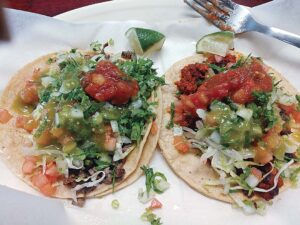
Asada (left) and chorizo (right) tacos from El Rey.
Pastor is also pork but is prepared quite differently. This culinary gem came to Mexico in the 19th century with Syrian and Lebanese immigrants. It is the New World equivalence of shawarma but with pork. Chops are sliced and stacked, sometimes with pineapple and onion, and roasted on a rotisserie, like shawarma or gyros. When done at its best, it has a crust on one side. Many places skip the rotisserie these days, but the best I ever had was at Rancho Allegre. Some places today serve “pastor” that is more like adobo — heavily marinated pulled pork. “Adobo” means “marinated” in Spanish, and the dish originated in the Philippines. Tacos tell a worldly story.
Chorizo is Spanish or Mexican sausage that is cured and smoked and can be added to a dish without further cooking. It is almost always flavored with garlic and paprika. Organ meats are returning. Cabeza (cheeks) and lengua (tongue) are making a comeback after disappearing in the mad cow terror. Brains are still sidelined. Cow heads are steamed to prepare these tender meats, which often now require an added surcharge. Tripas (small intestines) and buche (stomach) are again popular, sometimes only on weekends.
Asada is meat that is marinated and grilled. It is usually made with flank or skirt steak, and the popularity of carne asada is frequently cited for the steep increases in the price of those cuts of beef. In tacos, asada is either chopped, as at El Rey, or sliced, as at Malo. Birria and barbacoa are also popular taco meats. Both can be made with beef, lamb or goat, as they are at La Pena, Tacos La Familia and Baja Mexican Cocina. The latter two places will serve them with consommé of appropriate stocks, allowing one to turn a taco into a French dip.
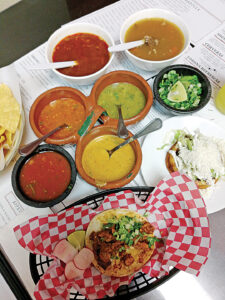
Tacos La Familia offers four salsas and two consommé choices with tacos.
Chicken tacos are now a rival to pork and beef. These are very easy to make at home. Get a giant rotisserie bird, still just $5 at Sam’s Club, buy some pico de gallo, cilantro, limes and tortillas. In San Francisco, Beijing duck tacos have made many toney Super Bowl parties. Chef George Formaro in Des Moines likes these duck tacos at home with smoked ducks from C Fresh Market and tortillas standing in for Mandarin pancakes. At Malo, he makes chicken tacos with thighs. Most places use breasts. At El Pollo Ranchero, roast chickens are made into enchiladas, wraps and burritos. Chicken is also sold by the piece with tortillas, cilantro and onions for taco lovers. Jethro’s serves BBQ chicken quesadillas and tacos, a popular practice in Mississippi and Texas.
Modern dieters have revived the fish and seafood taco. Evidence suggests fish tacos were eaten 3,000 years ago in Mexico. Ceviche tostadas are big now in Des Moines. Los Laureles, Mojitos Cantina and Isla del Pacifico have several kinds. Malo makes both a shrimp and a vegan ceviche, served with tortilla chips.
Fish tacos are gaining popularity all over town. Usually made with fried cod, they also employ tilapia, mahimahi and catfish. Seafood can be found with tortillas in many forms, even octopus. Mojito’s has a seafood tower that includes shrimp, octopus, scallops and catfish and can feed four people. Vegetarians are making rajas (chille strips) and nopales (prickly pear cactus paddles) popular.
Condiments
Some taquerias now offer as many as five, usually freshly made, salsas. Cilantro, onions and lime are added in most traditional places; chopped lettuce, tomato and American cheese are often in American chains like Taco Bell. Taco Johns goes both ways. Sour cream, Cotija cheese and guacamole are additional options, sometimes at added prices.
Salsas provide the heat. Taco Casa, which has been around since 1973, offers six different homemade salsas. Many places make at least three. Abelardo’s has a chart rating the heat content of each condiment.
Mexican restaurants are the future of central Iowa cuisine. Army Post Road, East 14th Street, East Grand and Oralabor in Ankeny are becoming Mexican café corridors. People love the food and prices. Tacos are the star of the price list. Many places offer taco special prices, on Tuesdays at Taco John’s, Malo, Tacos La Familia, Baja Mexican Cocina and on Wednesday and Thursdays at Tacos Marianna.
The Ultimate Taco
Each fall, CITYVIEW opens a contest to let our readers select the ultimate local version of a popular food. Sandwich lovers picked B&B Grocery Meat & Deli’s pork tenderloin as the ultimate sandwich. Steakhouse fans went with Chicago Speakeasy, noodle lovers chose Noodle Zoo, steak de Burgo fans chose Irina’s, burger lovers went with Café at the Meadows, and later with Dirt Burger. Barbecue aficionados selected Woody’s. Three times we held pizza runoffs, with Gusto yielding its title to Taste of New York, which repeated three years ago. In this, the most contentious of non-Presidential political years, we decided it was time to let you pick the ultimate taco in town.
Food is the new politics. Both subjects inspire intense loyalties that are usually only shared by members of the same tribe. Just as Alexandria Ocasio-Cortez fans can’t comprehend how anyone could support fully funded police forces, lovers of two soft tortilla carnitas taco fans can’t understand U-shaped ground beef tacos with American cheese. If anything, food arguments are more splintered than political ones. That’s probably because every human has a unique combination of 2,000 to 8,000 different “taste buds,” each of which can be more or less sensitive from one person’s tongue to another’s. Those different combinations are as distinctive as fingerprints, yet most people want others to like eating the same things they like to eat. I know couples who broke up over food selections, and women who dumped boyfriends for not allowing them to eat off their plates.
At CITYVIEW, the First Amendment is our favorite. We love a good argument. We leave the complexity of political polling to Ann Selzer (who is also a font of food information). However, to determine a consensus about more intricate local tastes, we instigated the Ultimate Food Challenge in 2010. This year it is the ultimate taco. Voting results and rules will be posted regularly on our web page and in this magazine. If you care about tacos, it is your culinary duty to vote. http://ultimatefoodchallenge.dmcityview.com ♦






















Hey Duncan, Gerry Fontanini here.
I’m so pleased that today, out of nowhere, I received, via Facebook, your recent Cityview column about the Ultimate Taco Challenge and I LOVED IT! Your history of tacos is so interesting, esp the part about the Mitla family of San Bernardino. I want to remind you that, way back when, you have eaten at the the Mitla Cafe in San Bernardino several times : The best ever huevos rancheros on Sunday mornings!
In addition, after reading your taco write up, I’m amazed at the ubiquity and variety of tacos/ Mexican food in DM. Sounds delicioso!
I hope all is well with you.
Gerry ❤️
…I was too late to vote in round one…I would have submitted a vot for my favorite Mariannas..
Gerri, thanks for reminders. We all had as much fun as not back in the bad old days of Berdoo, no? I also heard from Mitla owners.